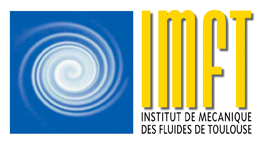Experimental study of flame stabilization in porous burners: application of optical diagnostics in 3D printed geometries
Enrique Flores-Montoya
Mercredi 2 octobre à 14 h 00 Amphithéâtre Nougaro
Abstract
Porous Media Burners (PMBs) are a combustion technology based on heat recirculation where a flame is stabilized within the cavities of an inert porous matrix. In PMBs, heat is transferred upstream from the burned to the unburned gas through the solid matrix yielding a preheating of the reactants. This increases their burning rate allowing for more compact combustion devices and the operation beyond conventional flammability limits. As a result, the stabilization of flames at ultra-lean equivalence ratios is possible, with the subsequent reduction of the flame temperature and NOx emissions. In these burners, a substantial fraction of the power is radiated by the hot solid phase, with radiated power fractions ranging between 20 − 30%. This, together with their elevated efficiency and low pollutant emissions, has motivated their commercial use in various infrared heating applications. In the past years, PMBs have received renewed interest owing to their potential as fuel flexible burners. Their ability to stabilize flames over a wide range of burning rates makes them promising candidates to handle the uneven flame properties of hydrogen and hydrocarbon fuels.
The mechanism of heat recirculation in PMBs is well understood. However, there is still limi- ted knowledge about many pore-scale phenomena that have a critical impact on the macroscopic behavior of the system and its performance. Advanced nonintrusive diagnostics could be used to study local flame stabilization mechanisms and improve current models. However, experimental measurements in PMBs are hindered by the lack of optical access to the interior of the porous matrix. This dissertation presents an experimental study on porous media combustion and is devoted to the application of optical diagnostics. Optically accessible PMBs are produced by combining computer-defined topologies with additive manufacturing techniques. This metho- dology provides an extensive optical access in a 3D burner configuration without altering the matrix structure. Optical access is leveraged to apply CH⋆ chemiluminescence, Mie-scattering imaging and μPIV. Topology tailoring is exploited to analyze the influence of the geometrical parameters of the porous matrix. Direct flame visualization enables the tracking of the reaction region as a function of the operating conditions, which can be used for model validation. The present results bring to light several limitations of current low order models and highlight the influence of the pore size on flame stabilization. Flame-front tracking is also used to investi- gate the effect of H2-enrichment on the behavior of the flame. This technique reveals different stabilization trends in H2-enriched flames that are not well retrieved by current models. Mie- scattering permits the quantification of the re-equilibration distance and the analysis of the flame shape. μPIV measurements show the influence of the topology on the interstitial flow and on the contribution of hydrodynamic effects to flame stabilization.
This PhD seeks to open new paths for the application of non-intrusive diagnostics in PMBs and to improve the current understanding of flame stabilization mechanisms.
Supervisors: Laurent Selle & Thierry Schuller
Résumé en Français:
Ce travail de thèse a été réalisé dans le cadre du projet ANR MIMOSAH qui vise à caractériser la combustion d’hydrogène en lit fluidisé, en
présence de particules partiellement inertes, avec prise en compte de réactions de surface. L’objectif est de modéliser la combustion en
milieu particulaire de la micro à la macro-échelle, avec une double approche numérique et expérimentale. Cette thèse concerne l’approche
numérique à l’échelle microscopique, et plus particulièrement le développement d’une stratégie numérique pour la simulation numérique
directe de la combustion d’hydrogène en présence de particules complètement résolues. Le point de départ de ce travail est le code
RESPECT, basé sur la résolution d’une formulation monofluide sur maillage Cartésien, doublée d’une méthode de pénalisation visqueuse pour
traiter l’interaction fluide solide. Initialement, le code avait été validé uniquement dans un contexte incompressible et anisotherme, sans
inclure de modèles pour les phénomènes de combustion gazeuse et de chimie de surface. Ce travail présente donc une série de développements
formels puis numériques, en vue d’intégrer la description de ces phénomènes dans le code RESPECT.
Dans un premier temps, des dévelopements formels sont présentés. Une formulation « single-field » au sens des distributions est développée pour
décrire l’écoulement réactif gaz-solide, afin d’adapter et étendre le travail de Kataoka [IJMF, 1986] au contexte de la thèse. Ensuite, un
lissage spatial est appliqué aux équations obtenues, dans l’objectif de dériver une formulation monofluide rigoureuse. Dans un second temps, des développements numériques sont abordés. Puisque les réactions de surface apparaissent dans la formulation « single-field » sous la forme de termes sources interfaciaux singuliers, une méthode géométrique est d’abord développée et validée pour discrétiser ce type de termes. Ensuite, le
cœur du travail de thèse est abordé, qui concerne l’extension du code RESPECT pour prendre en compte le caractère multi-espèce réactif de la
phase gazeuse, avec des particules solides immobiles et en l’absence de réaction de surface. Cette extension est basée sur le schéma faiblement compressible de Caltagirone et al. [Computers & Fluids, 2011]. Des simulations numériques de la combustion hydrogène/air, d’abord en l’absence de solides et ensuite en présence d’un milieu solide inerte sont enfin réalisées à des fins de validation et d’analyse.
Directeur de thèse : Enrica Masi, MdC IMFT/UPS
Co-encadrant : Amine Chadil, Ingénieur de recherche laboratoire MSME/CNRS
